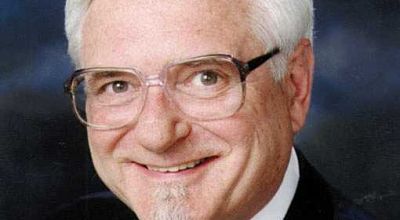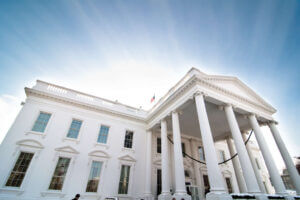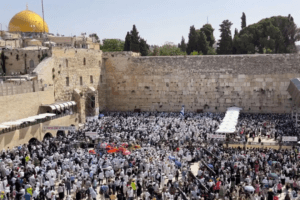NPR on Wednesday published an article called, “The New Apostolic Reformation: The Evangelicals Engaged in Spiritual Warfare.” The article names C. Peter Wagner as the movement’s architect and ties Texas Gov. Rick Perry and other politicians to NAR in a negative light. Wagner has been observing how the media is working to taint Christian political candidates with false notions about the NAR and wrote the following article to explain what the NAR is—and what the NAR is not.
Surprisingly, the New Apostolic Reformation has recently become a topic of discussion in the political media. I noticed some mention of it in connection with Sarah Palin’s run for vice president, but I considered it relatively insignificant. Then more talk of the NAR surfaced around Michelle Bachman, but it soared to a new level when Rick Perry entered the race for the Republican nomination for President in August.
The best I can discern, the NAR has become a tool in the hands of certain liberal opponents of the conservative candidates designed to discredit them on the basis of their friendship with certain Christian leaders supposedly affiliated with the NAR. To bolster this attempt, they seek to accuse the NAR of teaching false doctrine and paste on it the label of “cult.” For example, Forgotten Word Ministries posts an article by Marsha West expressing concerns about Rick Perry’s prayer assembly in Houston on August 6, that uses the title: “Texas Governor’s Upcoming Leadership Event Includes Cult Members.”
Soon after the event, nothing less than Al-Jazeera News picked up on the theme and posted an article on the NAR under the title “America’s own Taliban.” My name comes up in most of the Internet postings on NAR, but in this one I am called the “intellectual godfather” of the movement. When I read that, I felt that I had a responsibility to attempt to bring some clarification as to what the NAR is, what are its goals, and how these goals are being implemented.
What Is the NAR?
The NAR is definitely not a cult. Those who affiliate with it believe the Apostles’ Creed and all the standard classic statements of Christian doctrine. It will surprise some to know that the NAR embraces the largest non-Catholic segment of world Christianity. It is also the fastest growing segment, the only segment of Christianity currently growing faster than the world population and faster than Islam. Christianity is booming now in the Global South which includes sub-Saharan Africa, Latin America, and large parts of Asia. Most of the new churches in the Global South, even including many which belong to denominations, would comfortably fit the NAR template.
The NAR represents the most radical change in the way of doing church since the Protestant Reformation. This is not a doctrinal change. We adhere to the major tenets of the Reformation: the authority of Scripture, justification by faith, and the priesthood of all believers. But the quality of church life, the governance of the church, the worship, the theology of prayer, the missional goals, the optimistic vision for the future, and other features, constitute quite a change from traditional Protestantism.
The NAR is not an organization. No one can join or carry a card. It has no leader. I have been called the “founder,” but this is not the case. One reason I might be seen as an “intellectual godfather” is that I might have been the first to observe the movement, give a name to it, and describe its characteristics as I saw them. When this began to come together through my research in 1993, I was professor of Church Growth at Fuller Theological Seminary, where I taught for 30 years.
The roots of the NAR go back to the beginning of the African Independent Church Movement in 1900, the Chinese House Church Movement beginning in 1976, the U.S. Independent Charismatic Movement beginning in the 1970s and the Latin American Grassroots Church Movement beginning around the same time. I was neither the founder nor a member of any of these movements, I was simply a professor who observed that they were the fastest growing churches in their respective regions and that they had a number of common characteristics.
If I was going to write about this phenomenal move of the Holy Spirit, I knew I had to give it a name. I tried “Postdenominational” but soon dropped it because of the objections of many of my friends who were denominational executives. Then, in 1994, I tested “New Apostolic Reformation.” “Reformation” because the movement matched the Protestant Reformation in world impact; “Apostolic” because of all the changes the most radical one was apostolic governance, which I’ll explain in due time; and “New” because several churches and denominations already carried the name “apostolic,” but they did not fit the NAR pattern. Other names of this movement which are more or less synonymous with NAR have been “Neopentecostal,” “Neocharismatic,” “Independent,” or “Nondenominational.”
I am rather fascinated at the lists of individuals whom the media glibly connects with the NAR. I’m sure that some of them wouldn’t even recognize the term. In many cases, however, they would fit the NAR template, but since the NAR has no membership list they themselves would need to say whether they consider themselves affiliated or not.
Concerns about the NAR
If the critics are using openness to NAR as a slur against conservative political candidates, they obviously need to verbalize what could be wrong with NAR in the first place. To suppose that NAR is a “cult” or that it teaches “heresy” can be attributed only to sloppy or immature journalism. All too often “heresy” has come to mean only that the person disagrees with me and my friends, but the purpose of using the word is to project guilt by association on the politician. It attempts to implant a question: Who would vote for a heretic? But there is little evidence presented that the issue in question incorporates the doctrinal unorthodoxy of a true heresy. Instead, key words are usually dropped which describe legitimate areas of disagreement among Christian theologians on the level of whether or not we baptize infants. Neither of the opposite positions on matters like this deserve to be placed in the category of heresy.
Let me review the media pieces I have collected and pick out some key words in order to clarify my position. I say “my position,” because others in NAR might not agree with me, and they are not compelled to do so. NAR has no official statements of theology or ecclesiology, although a large number of us do happen to agree upon many somewhat radical conclusions. Most of us have long track records of service within traditional Christianity, and we have needed to go through paradigm shifts to get where we are now. Keep in mind that one of the affects of every paradigm shift is that some people get pulled out of their comfort zones. One of the reasons for opposition to some of the more radical ideas of NAR is that certain people have decided not to change and they are upset with those who have chosen to change.
Apostolic governance. As I mentioned before, this is probably the most radical change. I take literally St. Paul’s words that Jesus, at His ascension into heaven, “gave some to be apostles, some prophets, some evangelists, and some pastors and teachers for the equipping of the saints for the work of ministry” (Ephesians 4:11-12). Most of traditional Christianity accepts evangelists, pastors, and teachers, but not apostles and prophets. I think that all five are given to be active in churches today. In fact, St. Paul goes on to say, “And God has appointed these in the church: first apostles, second prophets, third teachers…” (1 Corinthians 12:28). This does not describe a hierarchy, but a divine order. Apostles are first in that order.
I strongly object to journalists using the adjective “self-appointed” or “self-declared” when referring to apostles. No true apostle is self-appointed. First of all, they are gifted by God for that ministry. Secondly, the gift and its fruit are recognized by peers and the apostle is “set in” or “commissioned” to the office of apostle by other respected and qualified leaders.
The office of prophet. Prophets are prominent in the Bible, both in the Old Testament and in the New Testament. As we just saw above, apostles are first and prophets are second. Every apostle needs alignment with prophets and every prophet needs apostolic alignment. One of the reasons why both should be active in our churches today is that the Bible says, “Surely God does nothing unless He reveals His secret to His servants the prophets” (Amos 3:7). And also: “Believe in the Lord your God and you shall be established; believe His prophets and you shall prosper” (2 Chronicles 20:20). I want to prosper and I want you to prosper.
Dominionism. This refers to the desire that some of my friends and I have to follow Jesus and do what He wants. One of the things He does want He taught us to pray for in the Lord’s Prayer: “Your kingdom come, Your will be done on earth as it is in heaven.” This means that we do our best to see that what we know is characteristic of heaven work its way into the warp and woof of our society here on earth. Think of heaven: no injustice, no poverty, righteousness, peace, prosperity, no disease, love, no corruption, no crime, no misery, no racism, and I could go on. Wouldn’t you like your city to display those characteristics?
But where does dominion come in? On the first page of the Bible, God told Adam and Eve to “fill the earth and subdue it; have dominion over the fish of the sea, etc.” (Genesis 1:28). Adam, Eve, and the whole human race were to take dominion over the rest of creation, but Satan entered the picture, succeeded in usurping Adam’s dominion for himself and became what Jesus calls “the ruler of this world” (John 14:30). When Jesus came, He brought the kingdom of God and He expects His kingdom-minded people to take whatever action is needed to push back the long-standing kingdom of Satan and bring the peace and prosperity of His kingdom here on earth. This is what we mean by dominionism.
A theocracy. The usual meaning of theocracy is that a nation is run by authorized representatives of the church or its functional religious equivalent. Everyone I know in NAR would absolutely reject this idea, thinking back to Constantine’s failed experiment or some of the oppressive Islamic governments today. The way to achieve dominion is not to become “America’s Taliban,” but rather to have kingdom-minded people in every one of the Seven Mountains: Religion, Family, Education, Government, Media, Arts & Entertainment, and Business so that they can use their influence to create an environment in which the blessings and prosperity of the Kingdom of God can permeate all areas of society.
Extra-biblical revelation. Some object to the notion that God communicates directly with us, supposing that everything that God wanted to reveal He revealed in the Bible. This cannot be true, however, because there is nothing in the Bible that says it has 66 books. It actually took God a couple of hundred years to reveal to the church which writings should be included in the Bible and which should not. That is extra-biblical revelation. Even so, Catholics and Protestants still disagree on the number. Beyond that, I believe that prayer is two way, we speak to God and expect Him to speak with us. We can hear God’s voice. He also reveals new things to prophets as we have seen. The one major rule governing any new revelation from God is that it cannot contradict what has already been written in the Bible. It may supplement it, however.
Supernatural signs and wonders. I have a hard time understanding why some include this in their list of “heresies.” Whenever Jesus sent out His disciples He told them to heal the sick and cast out demons. Why we should expect that He has anything else in mind for us today is puzzling. True, this still pulls some traditionalists out of their comfort zones, but that just goes with the territory. One critic claimed that the NAR has excessive fixation on Satan and demonic spirits. This is purely a judgment call, and it may only mean that we cast out more demons than they do. So what?
Relational Structures
Some of the authors I read expressed certain frustrations because they found it difficult to get their arms around the NAR. They couldn’t find a top leader or even a leadership team. There was no newsletter. The NAR didn’t have an annual meeting. There was no printed doctrinal statement or code of ethics. This was very different from dealing with traditional denominations. The reason behind this is that, whereas denominations are legal structures, the NAR is a relational structure. Everyone is related to, or aligned, with an apostle or apostles. This alignment is voluntary. There is no legal tie that binds it. In fact, some have dual alignment or multiple alignment. Apostles are not in competition with each other, they are in cahoots. They do not seek the best for themselves, but for those who choose to align with them. If the spotlight comes on them, they will accept it, but they do not seek it.
The key to this? The mutual and overriding desire that “Your kingdom come, Your will be done on earth as it is in heaven!”
C. Peter Wagner is the president of the Global Harvest Ministries and Chancellor of the Wagner Leadership Institute. Established in 1998, the Institute equips men and women for leadership positions in churches and translocal ministries. It is designed especially, but not exclusively, to meet the needs of leaders who have become a part of the New Apostolic reformation. Missions have been a watermark of Wagner’s career. From 1956 to 1971, he and his wife, Doris, served as missionaries in Bolivia under the South American Mission and Andes Evangelical Mission (now SIM International).
See an error in this article?
To contact us or to submit an article






















